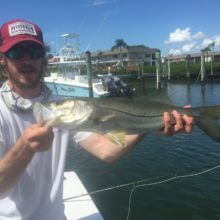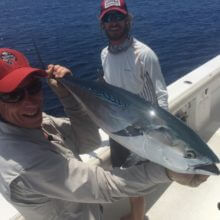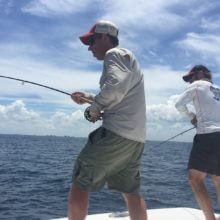SCOTT MERIDIAN WINS OVERALL BEST OF SHOW, ICAST, 2015
Meet the Scott Meridian. In this article, we introduce this stunning saltwater fly rod with information about its design and components, field testing and a thorough model-by-model review.
Meridian Design and Components
Scott Meridian Saltwater Fly Rods combine Radian stabilizing technology with Jim Bartschi’s sensational tapers for the lightest, most powerful, most accurate saltwater fly rod Scott has ever designed. The dominance of the Radian inspired Bartschi to create a saltwater series with equal appeal, utilizing X-Core scrim in Scott’s proprietary ReAct Technology package. Key componentry includes:
~ Scott’s unique saltwater Wells grip, more comfortable than all the others thanks to its assymetry. Scott makes these grips one at a time in their Montrose factory.
~ Custom designed reel seat made from aircraft grade aluminum. The seat has self-indexing hoods and deeply knurled double lock rings, easy to turn with wet hands. The line weight is lazer  engraved on the seat so you always grab the right rod.
engraved on the seat so you always grab the right rod.
~ Gorgeous new fighting butt designed to reduce sharp angles.
~ Stripping guides: SiC rings in full titanium frames.
~ Snake guides: nickel titanium Recoil.
~ Case: heavy duty aluminum with separate partitioned cloth liner.
True to Scott, the Meridian Series is still approachable by every day anglers. The rod loads and casts beautifully at short range and builds line speed with each increment of distance. It drives razor casting loops into heavy wind, turning over wind-resistant flies on long leaders. Some will choose the Meridian for its componentry and stunning looks, all intended to instill pride of ownership in the angler.
Meridian Field Testing
The Meridian may be the lightest saltwater rod of all time, but rigorous testing has established an impeccable track record for durability. Bartschi offers, “The Meridian is the most tested Scott fly rod of all time, by a mile.” Prior to introduction, 20-year Scott Pro Doug Kilpatrick landed over 35 tarpon on the 12-weight prototype. More than 100 tarpon have now been landed on the proto 11 and 12-weights without a single broken stick. The rod has created such a buzz within the industry that famous captains who have not traditionally supported Scott Fly Rods have come out of the woodwork to try them. Captains Dustin Huff, John O’Hearn, Joe Rodriguez and decorated tournament captain Scott Collins have all fished the Meridian. Scott’s dedicated pro staff have put hundreds of days on the Meridian from the bass shoals of Massachusetts to the Louisiana bayous to Key West.
On Monday and Tuesday before the show Richard Post, John Duncan and Jon Blackstone fished the Meridian 908-4 and 9010-4 near Jupiter, Florida for 8 species including the hard running false albacore, snook and runners. We were even more impressed than when lawn casting these new rods. We can’t overstate how easy the Meridian Series is to cast. We fished with a wide range of floating and sinking lines and came to the conclusion that the Meridian is the easiest casting saltwater rod we’ve ever fished. Anglers are likely to generate more line speed with greater accuracy with the Meridian than any other rod they could possibly have in their hands. Our captain, Ron Doerr, expected the Meridian to lack fish fighting power, but even he was impressed with the rod’s ability to horse deep running fish to the boat. On more than 30 occasions our Meridians were doubled over, the top 5-6 snake guides fully under water as we raced around the perimeter, stabbing the rod tip deep to avoid the props and sharp parts of the 32 foot catamaran.
In mid-May, Telluride Angler was invited to cast the final prototypes at the Scott factory in Montrose. Following are our comments on the most important models:
Scott Meridian Model Reviews
Scott Meridian 906-4
The Meridian 906-4 feels even lighter and more crisp than its larger relatives. Like all the other 9-footers, the fast action nature of the 906-4 doesn’t make this rod tricky to cast. The caster still has terrific loop control. The rod literally casts well from 20 to 90 feet. Scott has made many outstanding 6-wt saltwater rods over the years, starting with the 906-4 STS from 1995. This is the best one ever, hands down. The rod is very fast action, however. Anglers accustomed to fishing their 6-wt saltwater rods in freshwater should probably plan to overline this stick with a 7-weight.
Line Suggestions: Rio Bonefish WF6F, SA Bonefish WF6F, SA Redfish WF6F (new version), SA Intermediate Full Sink Saltwater WF6F, Rio InTouch Gold WF7F (for freshwater).
Meridian 907-4
Almost perfect from the first prototype, the 907-4 continues Scott’s legacy of making the finest 7-weights on the planet. The feeling of lightness cannot be overstated. Some rods “cast light” and some merely “feel light in the hand.” The Meridian 907-4 gives you both. This is an explosive caster from 20’ to 90.’
Meridian 908-4
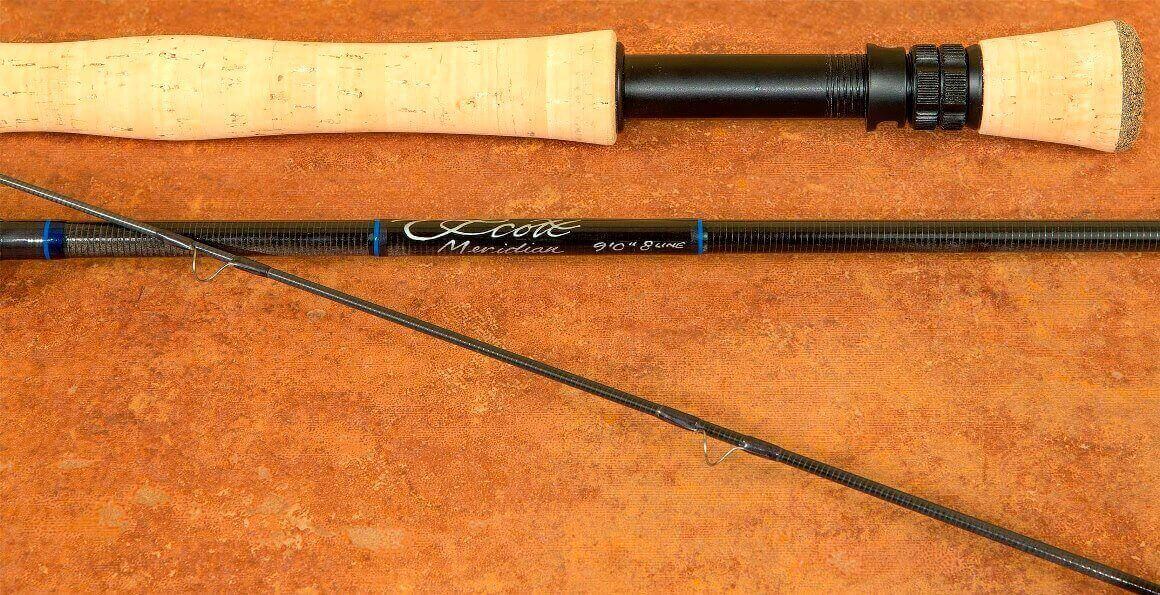 Once again, we are stunned by the lightness of this rod. When casting on the lawn in Montrose, we compared the Meridian to the same model from several other rod makers. The Meridian is simply lighter, right out of the case. When casting, it feels ever more weightless, by comparison, because the caster is never challenged to load or unload the rod. It’s almost effortless. The SA Bonefish taper we used is ideal on this rod. The wading angler will find that maximum line speed is gained in the 40’-75’ range, the typical distance for bonefish and reds. We believe the Meridian will actually reduce false casts by as much as 1-2 whole strokes in delivering the fly on a typical shot. The key to the Meridian’s action is sensational “recovery speed.”
Once again, we are stunned by the lightness of this rod. When casting on the lawn in Montrose, we compared the Meridian to the same model from several other rod makers. The Meridian is simply lighter, right out of the case. When casting, it feels ever more weightless, by comparison, because the caster is never challenged to load or unload the rod. It’s almost effortless. The SA Bonefish taper we used is ideal on this rod. The wading angler will find that maximum line speed is gained in the 40’-75’ range, the typical distance for bonefish and reds. We believe the Meridian will actually reduce false casts by as much as 1-2 whole strokes in delivering the fly on a typical shot. The key to the Meridian’s action is sensational “recovery speed.”
It is also notable that the Meridian 908-4 responds to a wide range of casting techniques. Like most Scott rods, a long, smooth stroke will load the rod deeply for maximum distance. Amazingly, it is also a punchy tip caster. It’s really hard to throw a tailing loop with this stick. Push the tip as hard as you can and what do you get? 100-foot casts.
Meridian 909-4
In all our experience, we have never cast a better 9-weight. The rod would probably handle any fly line, but with the SA Bonefish, this must be the most powerful 9-weight ever made. Power comes on every cast, from 30 feet to over 110. The key is a progressive fast action that makes every false cast count. So many “powerful” saltwater rods don’t flex until you have 50-60 feet in the air, at which point the butt section kicks in. The Meridian gets you to distance faster because every false cast counts, the rod loading and snapping back, line speed building on each stroke. What an amazing feeling. The 909-4 has all the stability in the world for turning over long leaders in the wind. This rod was made for the Keys.
Meridian 9010-4
The finest 10-weight Scott has ever made. Built on a similar taper to the 909-4, the 9010-4 rips out huge casts straight into the wind. Like the 908-4 and 909-4, the 9010-4 can handle the most vicious tip casts, forming bullet loops and sending the line head toward the horizon. Although it’s hard to overload the Meridian 10-wt, we preferred the casting action with a more gradual taper, such as the Rio Tactical Tarpon line. Short headed lines will load and launch, but it seems a waste to bypass the control and casting feel gained with a longer headed line.
Meridian 9011-4
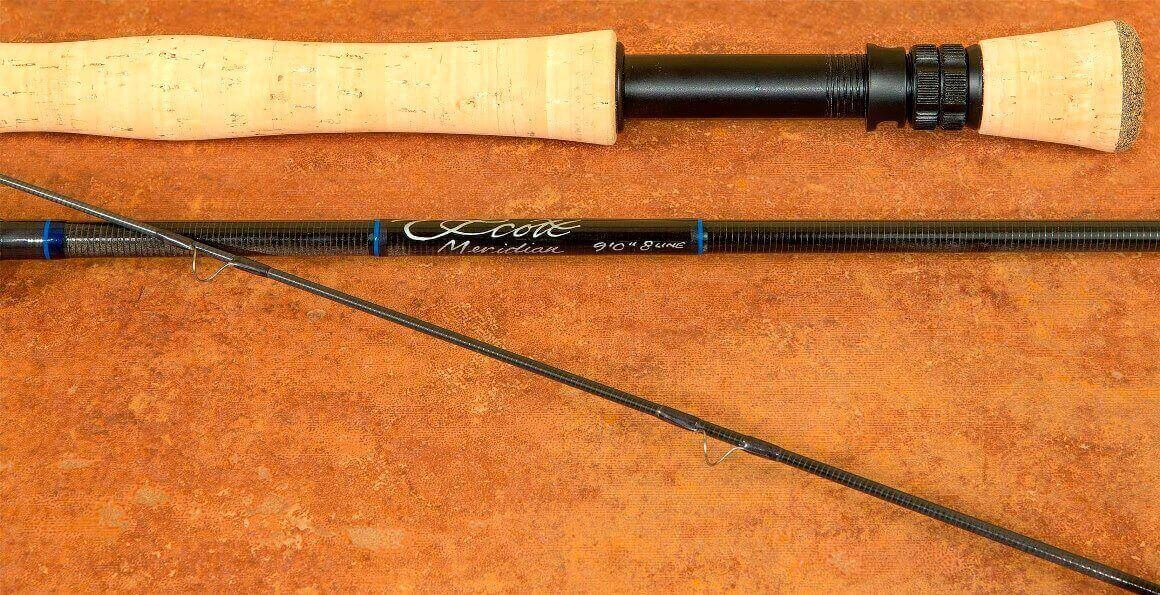 John Duncan’s comment summed up our feeling about this model: “This is the finest big game fly rod I have ever thrown.” We later learned that several other rod testers came to the same conclusion. The Meridian 11-weight is so light and powerful that we honestly expect this model to single-handedly cause a shift in tarpon rod sales back toward the 11-weight category. The rod is powerful in the hands of any caster, but what we all noticed was how few false casts were required to dump the entire fly line. “Fastest to the fish” seems a good way to describe the practical attributes of this rod’s sensational action.
John Duncan’s comment summed up our feeling about this model: “This is the finest big game fly rod I have ever thrown.” We later learned that several other rod testers came to the same conclusion. The Meridian 11-weight is so light and powerful that we honestly expect this model to single-handedly cause a shift in tarpon rod sales back toward the 11-weight category. The rod is powerful in the hands of any caster, but what we all noticed was how few false casts were required to dump the entire fly line. “Fastest to the fish” seems a good way to describe the practical attributes of this rod’s sensational action.
Meridian 9012-4
Fortunately, the biggest horse in the barn is easy to ride. The butt section feels enormously powerful, but the Meridian 9012-4 still loads with progression. As a consequence, we had an easy time casting the rod over 100 feet into a stiff quartering wind. From our experience, 12-weights are usually powerful but rarely easy to cast. This rod will fall into almost every angler’s hands with equal comfort. With a typical heavy-headed tarpon line, it is so explosive that the whole casting process literally takes less time. This is part casting efficiency and part line speed.
Meridian 848-4 (8’4” 8-wt 4-pc)
An 8’4” 8-wt is a niche rod for skiff anglers, so Scott will probably never sell very many of these. That is a shame. The Meridian 848-4 is the lightest, sweetest swinging 8-weight I have ever handled. The 9’ rod in the series will make more sense for wading anglers, but I strongly urge boat anglers to consider the 8’4” model. Thousands of anglers will cast this rod in the coming year and I bet every single one will come to the same conclusion. Some rods are so good that we just can’t describe them with words. As with many rods that come in a choice of lengths for a given line weight, the difference in “swing weight” is much greater than the net weight difference between rods. This is true for two reasons: 1) the lost weight from 8” less graphite and one or two less snake guides comes off the end of the rod, so the lever in your hands seems significantly lighter, and 2) the rod tip bears the weight of the fly line loop. With the shorter rod, the line weight feels closer to your body, lighter under the lever and more easily controlled. In addition to saltwater anglers, bass and pike fishermen should take note of this rod.
Line suggestions: SA Bonefish, SA Redfish (the new one, lightened to true line weight), RIO Bonefish, RIO Bonefish Quickshooter (underline by 1 to compensate for the extra heavy head) and RIO Redfish (underline by 1, same as Quickshooter).
Meridian 8410-4 (8’4″ 10-wt 4-pc)
For fun, we asked Bartschi to trot out one of his two shorter rods in the series. The 848-4 and 8410-4 were designed specifically for boat fishing, especially around mangroves, docks and other cover. In a word, the 8410-4 is “springy.” It’s really easy to cast, but also dead stable in the butt section for terrific accuracy. It should handle a wide range of lines and prove surprisingly versatile. We can easily imagine using this rod on open flats in addition to its ordained backcountry purposes. After feeling the stunning lightness of the 9’ models in the Meridian Series, we were not surprised at the lightness of this 8’ 4” model. A stout 10-weight by anyone’s measure, the 8410-4 honestly feels like a 7 or 8-weight fly rod.
Florida Field Test: Fly Fishing in Jupiter with Scott Meridian fly rods
2-Piece Meridians
All of the 2-piece rods in this series are stiffer than their 4-piece brothers. They are incredibly uniform in action and true to their line weights. This will be to the liking of Florida Keys captains, who often prefer the most powerful rods available for clients casting in heavy wind. Unlike most of us, saltwater guides can get away with 1 and 2-piece rods because the rods live on their boats. I did compare the 2-piece Meridians with 1-piece rods from two other big time rod makers (both of which are carried by Telluride Angler). We found the 2-piece Meridians to be lighter in real weight, lighter in apparent swing weight and more powerful than any of the 1-piece competitors. In the final analysis, however, the extra stiffness in the 2-piece Meridians may not be an advantage to our customers. As a caster, I lack the physical strength to cast the stiffest saltwater rods such as the Sage Salt 12-weight and Loomis NRX 11 and 12. Some of my bigger, stronger friends in the industry prefer the stiffest rods available, but I personally get more power from a rod with a forgiving tip. The Meridian 4-piece rods are easy to cast. Meridian 2-piecers are also easy to cast, but not as easy as the 4-piece models.
